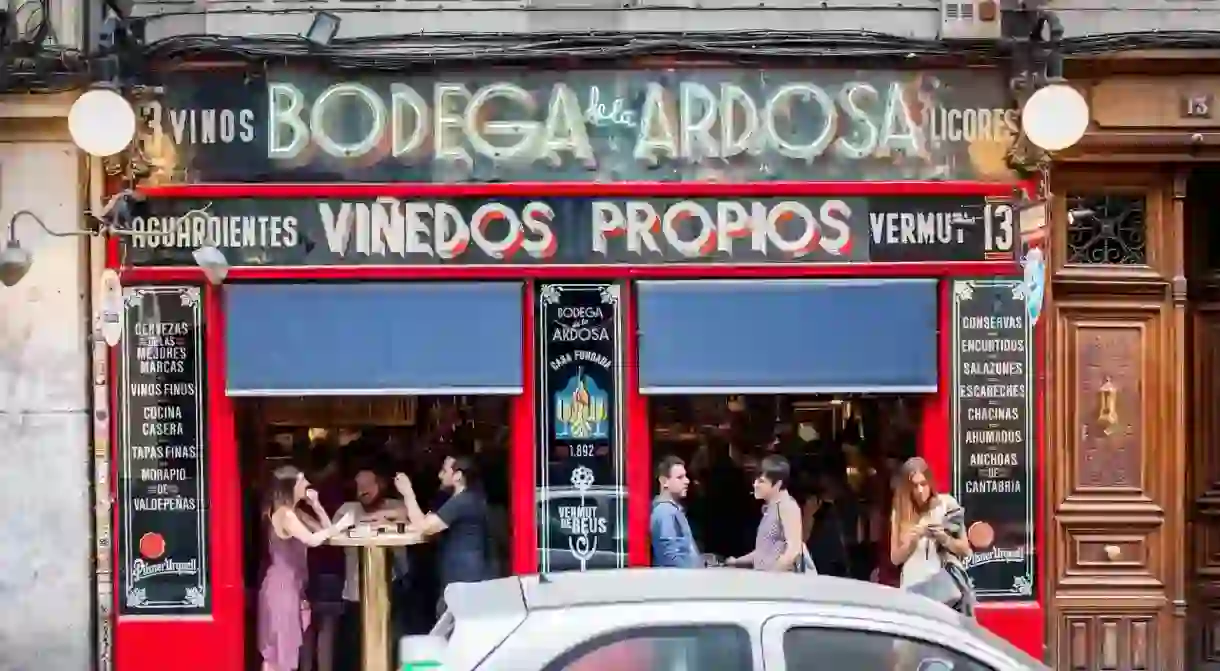Historic Restaurants in Madrid, Spain

As the seat of government, the official residence of the royal family and home to the country’s finest art galleries, plazas and museums, it’s fair to assume that Madrid, Spain’s capital city, has some pretty historic restaurants, too. And you’d be right of course: the city dates back to the era of Roman control and first gained capital status in 1561, providing a steady flow of money and people to the city’s restaurants for centuries. Here are Madrid’s best historic restaurants.
Interested in more foodie experiences around Spain? Join our four-day Mini Trip to the Basque Country to take a pinxtos tour in Bilbao and explore San Sebastian with a small group of like-minded travellers.
Sobrino de Botín, for the oldest restaurant in Spain
Restaurant, Spanish

In an article about historic restaurants, it would be rude not to start with what is generally agreed upon as being Spain’s oldest. Sobrino de Botín is fast approaching its tricentennial, after first opening in 1725. Everything about this place is a delight, from the antique wine cellar to the intimate dining rooms, all wrought in bare brick and withered wood. The house special is the cochinillo asado, a roast suckling pig served with parboiled potatoes.
Lhardy, for regional dishes
Cafe, Deli, Restaurant, Spanish, French

Near the Puerta del Sol square is Lhardy, a mere pup in comparison with Botín. But this Madrid favourite has been cooking up the regional dish of cocido madrileño – a stew of chickpeas, potatoes, cabbage and pork – since 1839. Dining here feels like being inside an opulent mansion, with its wooden wainscoting, red velvet curtains and large, gilt-edged mirrors. There are private dining rooms for groups. Be sure to leave room for the soufflé sorpresa, a soufflé with homemade vanilla ice cream.
Casa Alberto, for a mix of dining options
Restaurant, Spanish

Straddling the divide between fancy sit-down restaurant and traditional tapas bar is Casa Alberto, which opened in 1827. Passing through the classic wooden frontage – painted in Spain’s characteristic red, yellow and black – you’ll notice the tapas tropes of hams hanging from ceilings and folks at the bar sipping a vermouth or caña and nibbling small plates of tapas. The boquerones en vinagre (sardines in vinegar) are good here. At the back is the restaurant, surrounded by the obligatory old bullfighting posters.
Bodega de la Ardosa, for exceptional wines
Bar, Pub, Restaurant, Bodega, Spanish, Tapas, Wine, Beer

Perhaps one of Spain’s earliest chains of wine bars, Bodega de la Ardosa was established by D. Rafael Fernandéz, a vintner from Toledo who wanted to sell his wines more easily in Madrid. The bodega on Calle de Colón was the original, opened in 1892. The shelves behind the bar are stacked high with dusty old bottles. Classic tapas are done to a high standard, including the tortilla de patatas. For something more substantial, the fabes con calamares (beans and squid) go well with a glass of white wine.
Casa Ciriaco, for a fine dining experience
Restaurant, Spanish

Close to the Royal Palace and Almudena Cathedral, you’ll find one of the classiest historic restaurants in Madrid. The tables in the brick cellar are surrounded by shelves of vintage wines, and there’s a special table for larger groups in the main wine cellar. A tapas menu is served at the bar, with the pisto manchego con huevo (ratatouille with cheese and egg) an unconventional option. In the restaurant, the rabo de toro (oxtail) is a favourite.
Restaurante Malacatín, for local Madrilenian cuisine
Restaurant, Spanish

Seemingly frozen in time since opening in 1895, Malacatín is the place to go for anybody curious to explore cocina madrileña (Madrid cuisine) at its most authentic. It’s also for people who love walls and ceilings covered in curios, old photos and antiques like some haphazardly curated museum. They do a great cocido madrileño here, but if you’re feeling more adventurous, try callos a la madrileña, a soupy stew of chorizo, blood sausage, paprika and tripe.
Casa Labra, for simple but superb dishes
Bar, Restaurant, Spanish, Mediterranean, Beer

While many historic restaurants keenly cash in on their longevity, the modest Casa Labra keeps things simple and relatively good value. The menu is short, limiting tapas offerings to four or five options. Most people come for the house specialties: tajada de bacalao (deep fried cod chunks) and the croquetas de bacalao (cod croquettes). It’s really all about the cod, here; both pair superbly with a caña of cold beer.
Taberna Antonio Sánchez, for a bullfight atmosphere
Restaurant, Spanish

If bullfighting is a trigger, this isn’t the place for you, but this anachronistic tavern is certainly one of the most unique and traditional restaurants in Madrid. Two bull heads mounted on the wooden walls greet customers on entry to the taverna, which was first opened in 1787. The cellar space is filled with huge old pots, which were used for storage before fridges were invented. Among the tapas is a good array of options for vegetarians.
Restaurante Zalacaín, for a high-quality menu
Restaurant, European, Spanish

If your hunger for restaurants isn’t quite satisfied , check out some of Madrid’s most affordable places to eat after a long day experiencing all the things to see and do in the city, not least its fabulous museums. But of course you’ll need somewhere to stay, from boutique hotels to bed and breakfasts, Culture Trip has you covered.
This is an updated rewrite of an article originally by Thomas Rees.













